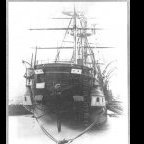-
Posts
3,867 -
Joined
-
Last visited
Reputation Activity
-
 KeithAug got a reaction from FriedClams in St Roch by Lecrenb - 1:48 scale - RCMP Schooner rigged as schooner c. 1930/35
KeithAug got a reaction from FriedClams in St Roch by Lecrenb - 1:48 scale - RCMP Schooner rigged as schooner c. 1930/35
I am always amazed how far Cornwall Model Boats business extends. Nearly as famous as Wall Drug.
Always a tricky and stressful job Bruce, but you executed it well.
-
 KeithAug got a reaction from FriedClams in USS San Pablo 1920 by Ras Ambrioso - Scale 1/64 - River Gunboat
KeithAug got a reaction from FriedClams in USS San Pablo 1920 by Ras Ambrioso - Scale 1/64 - River Gunboat
Another interesting vessel Ras. I look forward to seeing how she develops.
-
 KeithAug got a reaction from Keith Black in St Roch by Lecrenb - 1:48 scale - RCMP Schooner rigged as schooner c. 1930/35
KeithAug got a reaction from Keith Black in St Roch by Lecrenb - 1:48 scale - RCMP Schooner rigged as schooner c. 1930/35
I am always amazed how far Cornwall Model Boats business extends. Nearly as famous as Wall Drug.
Always a tricky and stressful job Bruce, but you executed it well.
-
 KeithAug got a reaction from Glen McGuire in Lancha Chilota by JacquesCousteau - FINISHED – Scale 1:32 – Chilean Coasting Sloop
KeithAug got a reaction from Glen McGuire in Lancha Chilota by JacquesCousteau - FINISHED – Scale 1:32 – Chilean Coasting Sloop
She is coming along very nicely.
-
 KeithAug got a reaction from mtaylor in USS Cape (MSI-2) by Dr PR - 1:48 - Inshore Minesweeper
KeithAug got a reaction from mtaylor in USS Cape (MSI-2) by Dr PR - 1:48 - Inshore Minesweeper
I presume the flower arrangement was standard naval issue Phil?🙂
-
 KeithAug reacted to Valeriy V in Pelican 1943 by FriedClams - 1:48 - Eastern-Rig Dragger
KeithAug reacted to Valeriy V in Pelican 1943 by FriedClams - 1:48 - Eastern-Rig Dragger
Gary, some of the things you do are beyond my comprehension! Especially when it comes to technologies that bring details closer to reality.
Excellent continuation of excellent work!
-
 KeithAug reacted to Lecrenb in St Roch by Lecrenb - 1:48 scale - RCMP Schooner rigged as schooner c. 1930/35
KeithAug reacted to Lecrenb in St Roch by Lecrenb - 1:48 scale - RCMP Schooner rigged as schooner c. 1930/35
Got the port rub rail on, and started some fiddly bits...
There are five fairleads that pass through St. Roch's bulwarks... since the flanges are visible on both sides I ordered 10 from Cornwall Model Boats. They are not the correct size so I used my small hobby vise and Zona saw to cut them down and glue them back together with CA...
Here is one being test fit to the bow, again use Forstner or brad point bits for drilling clean holes!
And here are the pair installed at the bow...
How I proceeded to make the hawse... this should be the last of the hole drilling forward of the poop deck!
I measured not twice, but three times, off the plans to locate the ends of each hawse pipe, double checking against photos and the model to ensure they are symmetrical on my hull...
After drilling the holes straight into the hull I used my 4" round file to set the hole profile.
Then my 1/4" styrene tube was fitted...
And the pipe marked for cutting...
I roughed in the hawse rubber on the deck, and the flange on the hull, and glued the flange to the pipe...
Then I filed and sanded the flange to shape, detailed the rubber, and test fit to the hull...
one more to make, then paint and they'll be ready for the anchors!
Stay tuned for more fiddly bits!
Regards,
Bruce
-
 KeithAug reacted to Lecrenb in St Roch by Lecrenb - 1:48 scale - RCMP Schooner rigged as schooner c. 1930/35
KeithAug reacted to Lecrenb in St Roch by Lecrenb - 1:48 scale - RCMP Schooner rigged as schooner c. 1930/35
I'm now making the chain plates... there are a total of 14; 3 each side of each mast and two main mast preventer stay plates.
They are made from simple steel bar stock that bolt flush to the hull, passing behind the rub rail and bolting below it. Turnbuckles that tension the standing rigging bolt to the top of each plate.
I derived the lengths of each plate (they are not all the same) by scaling from drawings. The first picture shows the two sets for the foremast, complete with turnbuckle ends I made from solid core solder.
I drilled a .020 hole through each assembly then pinned each shackle to its' plate with Grandt Line 1 1/2" scale bolts and washers...
The turnbuckles that tension the rigging have fork ends that bolt to the plates, but detailing those while installing the rigging would be a recipe for disaster! I plan on modifying the turnbuckle ends to fit over my 'shackles', so they will look like forked ends.
The plates are not straight up and down on the hull, they follow the line of the rigging. I temporarily set the mast and used thread to derive the correct line... in the picture the thread passes down the aft side of the mast to the rear chain plate.
And here are the port fore chain plates installed using CA glue.
Now to pin them into the hull, then do the other sets and move on to the rub rail, which is the last structural member of the hull!
Regards,
Bruce
-
 KeithAug reacted to Austin Cox in USS Cape (MSI-2) by Dr PR - 1:48 - Inshore Minesweeper
KeithAug reacted to Austin Cox in USS Cape (MSI-2) by Dr PR - 1:48 - Inshore Minesweeper
Phil,
I like your theory about the screw holes. 01 level has been changed significantly, but there may still be some things of interest to you. The bell is still there, one vent duct, the ladder on the port side, and of course the stack. The bow area was also changed a fair amount, but a few things are still there. I'll see about getting some pictures for you this weekend.
-
 KeithAug got a reaction from Keith Black in Cangarda 1901 by KeithAug - Scale 1:24 - Steam Yacht
KeithAug got a reaction from Keith Black in Cangarda 1901 by KeithAug - Scale 1:24 - Steam Yacht
Phil - Yes
-
 KeithAug got a reaction from mikegr in Libertad 1925 by Valeriy V - Scale 1:100 - Spanish Type F Light Cruiser
KeithAug got a reaction from mikegr in Libertad 1925 by Valeriy V - Scale 1:100 - Spanish Type F Light Cruiser
Not bad progress seeing as the log was only started 3 days ago!!!! I assume you started the build before you started the log Valeriy.
-
 KeithAug got a reaction from JacquesCousteau in Lancha Chilota by JacquesCousteau - FINISHED – Scale 1:32 – Chilean Coasting Sloop
KeithAug got a reaction from JacquesCousteau in Lancha Chilota by JacquesCousteau - FINISHED – Scale 1:32 – Chilean Coasting Sloop
She is coming along very nicely.
-
 KeithAug reacted to Valeriy V in Libertad 1925 by Valeriy V - Scale 1:100 - Spanish Type F Light Cruiser
KeithAug reacted to Valeriy V in Libertad 1925 by Valeriy V - Scale 1:100 - Spanish Type F Light Cruiser
The body of the model is covered with fiberglass and epoxy resin.
-
 KeithAug reacted to Valeriy V in Libertad 1925 by Valeriy V - Scale 1:100 - Spanish Type F Light Cruiser
KeithAug reacted to Valeriy V in Libertad 1925 by Valeriy V - Scale 1:100 - Spanish Type F Light Cruiser
The model hull is mounted on its own supports.
-
 KeithAug reacted to yvesvidal in Libertad 1925 by Valeriy V - Scale 1:100 - Spanish Type F Light Cruiser
KeithAug reacted to yvesvidal in Libertad 1925 by Valeriy V - Scale 1:100 - Spanish Type F Light Cruiser
I like the two semi-hulls assembly system, promoted by Billing Boats. So much easier and faster to plank and get a very nice, straight and sturdy hull.
Yves
-
 KeithAug reacted to Valeriy V in Libertad 1925 by Valeriy V - Scale 1:100 - Spanish Type F Light Cruiser
KeithAug reacted to Valeriy V in Libertad 1925 by Valeriy V - Scale 1:100 - Spanish Type F Light Cruiser
The hull is covered with wooden slats.
-
 KeithAug reacted to Valeriy V in Libertad 1925 by Valeriy V - Scale 1:100 - Spanish Type F Light Cruiser
KeithAug reacted to Valeriy V in Libertad 1925 by Valeriy V - Scale 1:100 - Spanish Type F Light Cruiser
My actions for making the cruiser hull are normal.
-
 KeithAug reacted to Valeriy V in Libertad 1925 by Valeriy V - Scale 1:100 - Spanish Type F Light Cruiser
KeithAug reacted to Valeriy V in Libertad 1925 by Valeriy V - Scale 1:100 - Spanish Type F Light Cruiser
Thanks to the efforts of our forum members JCARLOSM and Tony Hunt I have a set of detailed photos of this model.
I am very grateful and deeply thankful to them. Once again, thank you, friends!
-
 KeithAug reacted to Valeriy V in Libertad 1925 by Valeriy V - Scale 1:100 - Spanish Type F Light Cruiser
KeithAug reacted to Valeriy V in Libertad 1925 by Valeriy V - Scale 1:100 - Spanish Type F Light Cruiser
The Maritime Museum of Madrid has a magnificent model of the Libertad in 1:48 scale.
This model is the one that can replace the detailed photographs I am missing.
-
 KeithAug reacted to Valeriy V in Libertad 1925 by Valeriy V - Scale 1:100 - Spanish Type F Light Cruiser
KeithAug reacted to Valeriy V in Libertad 1925 by Valeriy V - Scale 1:100 - Spanish Type F Light Cruiser
In total, three ships were built according to this project, but I could only find two high-quality photographs necessary for ship modelers.They allow you to see the necessary details of the ship.
-
 KeithAug reacted to Valeriy V in Libertad 1925 by Valeriy V - Scale 1:100 - Spanish Type F Light Cruiser
KeithAug reacted to Valeriy V in Libertad 1925 by Valeriy V - Scale 1:100 - Spanish Type F Light Cruiser
As a result of further improvement of the "E" type cruiser project, in 1921 Watts created the project of the Spanish cruiser "F". Its hull and power plant almost completely repeated the British prototype, but the arrangement of the mechanisms was not echelon, but linear, which allowed to give the ships a more harmonious silhouette with two wide smoke pipes, grouped in the middle part.
The turbines and boilers were unified with the Churruka-class destroyers, which, in turn, were created on the basis of the British Scott-class leaders. Thus, the F-class cruisers were slightly superior in power (design - 83,000 hp) to their British E-class predecessors, being slightly faster. The armor remained virtually unchanged: the 76-mm main belt occupied about 40% of the hull length, covering only the engine and boiler rooms, with the belt thickness decreasing at the ends.
The armament was significantly improved. The main caliber artillery consisted of eight 152 mm Vickers guns and was placed in five mounts located in the centerline of the ship. The two end mounts were single-gun, and the other three (both elevated and the middle) were twin. Thus, all guns could participate in a broadside. The powerful artillery was supplemented by a branched and perfect for its time fire control system, including the main command and rangefinder post and two additional posts. The anti-aircraft armament was also strengthened and included four 102 mm guns, the torpedo armament remained unchanged: four triple-tube devices, unified with the Churruka destroyers.
-
 KeithAug reacted to Valeriy V in Libertad 1925 by Valeriy V - Scale 1:100 - Spanish Type F Light Cruiser
KeithAug reacted to Valeriy V in Libertad 1925 by Valeriy V - Scale 1:100 - Spanish Type F Light Cruiser
The cruiser was designed on the basis of the British "E" type.
-
 KeithAug reacted to JacquesCousteau in Lancha Chilota by JacquesCousteau - FINISHED – Scale 1:32 – Chilean Coasting Sloop
KeithAug reacted to JacquesCousteau in Lancha Chilota by JacquesCousteau - FINISHED – Scale 1:32 – Chilean Coasting Sloop
I think that's what they did, but I haven't found a clear photo. Many of the more recent lanchas for which better photos exist have lower bulwarks with less prominent stanchions.
To pin the stanchions in place, I started with wire (covered in superglue and inserted into pre-drilled holes). But after only a couple I realized that the wire was extremely difficult to push into the hole, as it obviously bends very easily. So I switched to a thin brass rod. This worked better, but still has a tendency to get stuck before getting to the necessary depth.
I also added the stern rail, first leaving it overlength for ease of gluing and later cutting to size. This will form the lower level, but there will be a second layer at the corners to meet the height of the bulwarks.
I also tapered the bowsprit with a mini plane and sandpaper.
Finally, I added the bow stanchions/angled blocks (I'm sure there's an actual name for these) to fit around the bowsprit.
Next up, the port stanchions.
-
 KeithAug reacted to wefalck in Lancha Chilota by JacquesCousteau - FINISHED – Scale 1:32 – Chilean Coasting Sloop
KeithAug reacted to wefalck in Lancha Chilota by JacquesCousteau - FINISHED – Scale 1:32 – Chilean Coasting Sloop
With these 'non-standardised' designs, one can always take a bit of artistic license. The builders themselves probably would have adapted to circumstances.
I wonder, why they used this stepped design of the stanchions? Did bolts go through the 'ears' into the covering board?
It is common design for rails to either extend the frames above the covering board or to bolt some thinner material to the frames that then extends upwards. However, these low rails probably only served to keep equipment or loads from rolling over board, so they don't need to be terribly sturdy.
-
 KeithAug reacted to JacquesCousteau in Lancha Chilota by JacquesCousteau - FINISHED – Scale 1:32 – Chilean Coasting Sloop
KeithAug reacted to JacquesCousteau in Lancha Chilota by JacquesCousteau - FINISHED – Scale 1:32 – Chilean Coasting Sloop
Thanks, Chris! I think there's a lot that I could be more precise about, but each build--and each part of the build--is a chance to improve.
I've been working on the stanchions.
Case in point about imprecision: while I was planning on doing ten stepped stanchions per side (besides the stern rail and the angled blocks around the bowsprit), I slightly adjusted locations while gluing and ended up with nine per side. I decided that this was fine, as this is a slightly small lancha. The bow block is not glued in the photo below.
In order to properly fit the bow blocks, I now had to fit the bowsprit saddle, which I had already colored with a gray wash. I ended up placing this a bit further back than given in the plans, and than may have been typical, because I thought it looked better. Nonetheless, I did make sure to find at least a photo or two of lanchas with a similar bowsprit saddle location. The bowsprit still needs to be shaped.
Next up, the port stanchions, aft rail, and angled blocks. I also will be testing drilling through the stanchions and the bowsprit to pin these in place with wire or brass rod, as they are not particularly securely glued and I would hate to snap them off by accident.






